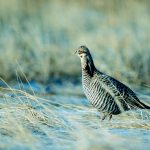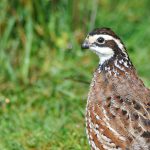The last few years have offered some of the finest chukar hunting in the last three decades. The 2016 chukar harvest in Nevada was the sixth best since 1992, Utah boasted stellar numbers for several years, Idaho was predictably good, and there were some incredible localized spikes – e.g., Malheur County of Oregon in 2016, Pine Forest Range of Nevada in 2017.
In Nevada, this season’s intrigue lies in the third wettest March on record that brought record snow-melt water to central Nevada through Elko, said Espinosa. That was followed by heavy rainfall in May, creating of carpet of green with abundant insects during the brood-rearing season. The moisture missed popular and traditional chukar hunting areas such as the Pine Forest, Black Rock, Jackson, and Calico mountain ranges, which Espinosa predicts will only offer fair chukar-hunting opportunities.
In Oregon, prospects are down due to some winter mortality over the last two years combined with dry conditions this summer, according to Mikal Cline, Oregon Department of Fish and Wildlife.
Idaho may be the best bet this winter. The spring weather was fantastic, with good amounts of rain at the right times, which should translate into abundant forbs and brood habitat, reports Knetter. “I honestly can’t think of a year that was any better.” The Salmon Region experienced a hard winter, so it’s probably best to focus on the Magic Valley, Southwest, and Clearwater Regions. Utah will be moderate to poor due to the lack of precipitation in key chukar ranges, said Robinson.
E-Blast Update: October 2018
The Great Basin is characterized by highly dynamic weather patterns, and chukars are a prolific gamebird that can reproduce at dizzying levels when conditions are right. These two truths lead to boom-and-bust patterns in chukar populations. That’s why most seasoned chukar hunters live by a simple ethic: Go where the getting is good. In 2018, chukar production was outstanding – at a minimum – in eastern Oregon and southwest Idaho, and this season may offer some of the best chukar hunting in years!
Surveys in Malheur County of southeastern Oregon revealed 47 chukars per 10 miles, a 48 percent increase from last year and 15 percent above the 10-year average. Brood size was way up with 11.6 chukars observed per brood, indicative of a great hatch and lots of young birds. The most productive routes were along the west side of the Owyhee Reservoir and Cottonwood Canyon southwest of Harper. Mikal Cline, Oregon Department of Fish and Wildlife Upland Game Bird Coordinator, sums it up succinctly: “This would be an excellent year to take to the field in eastern Oregon for chukar, quail, and partridge.”
It’s a similar story in adjoining western Idaho where chukar populations are expected to be excellent due to a mild winter and near-perfect timing of abundant spring rains! In the Southwest Region, good-sized chukar broods were reported near the Bruneau and East Fork Owyhee Rivers, and in the hills above Emmett. Andrus WMA, Owyhee Front, South Fork Boise River, and Owyhee Canyonlands are all expected to offer good chukar hunting this season. In the Clearwater Region, field observations are even more encouraging with lots of birds and numerous large broods.
Nevada is still an unknown at this juncture because the chukar survey data isn’t yet available. However, early reports were very promising for north-central and northeastern Nevada due to abundant rainfall in May which set the table for excellent chukar production. Look for the Nevada Chukar Forecast in the next couple of weeks at http://www.ndow.org/Hunt/Seasons_and_Regulations/Upland_Game/.





